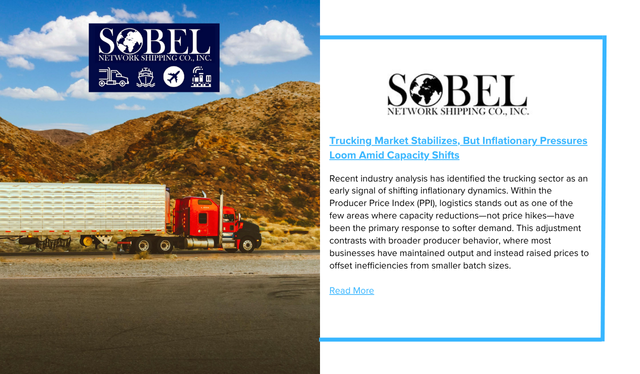Recent industry analysis has identified the trucking sector as an early signal of shifting inflationary dynamics. Within the Producer Price Index (PPI), logistics stands out as one of the few areas where capacity reductions—not price hikes—have been the primary response to softer demand. This adjustment contrasts with broader producer behavior, where most businesses have maintained output and instead raised prices to offset inefficiencies from smaller batch sizes.
As a leading indicator of inflation, the PPI offers insight into upstream cost pressures before they are felt by consumers. Logistics, as a key PPI component, is now showing signs of moving into an inflationary cycle driven by constrained capacity rather than surging demand.
Over the past few years, the trucking industry has endured extreme volatility. After the surge in freight demand during the COVID-19 pandemic, the market became oversaturated with capacity. Small and midsize carriers struggled to remain profitable amid flat spot rates and rising operational costs—prompting a wave of market exits that has only recently begun to restore balance.
This rebalancing is reflected in several market indicators. The Outbound Tender Rejection Index—a key measure of freight market tightness—has surpassed 6.5%, suggesting that carriers are regaining pricing power. In fact, spot truckload rates (excluding fuel) rose over 9% year-over-year in Q1 2025, on top of double-digit gains in late 2024.
However, the recovery has not been evenly distributed. Regional data shows capacity constraints are most acute in the Southeast, while markets on the West Coast continue to experience softer demand. Inland freight hubs such as Atlanta, Chicago, and Dallas have emerged as key pinch points.
Looking ahead, the direction of transportation costs remains highly sensitive to external factors. Ongoing tariff uncertainty and trade policy developments continue to influence market dynamics, with purchasing behavior across industries remaining erratic. While demand levels appear stable, inconsistent order patterns and tariff-driven disruptions are making it more difficult for carriers to plan effectively.
Forecasts suggest continued upward pressure on trucking prices in the months ahead. Industry expectations for transportation pricing remain elevated, with many anticipating higher rates throughout the coming year. As capacity continues to normalize, the sector is positioned for increased volatility, particularly if GDP growth accelerates or trade friction escalates.
For logistics stakeholders, these developments underscore the critical role trucking plays in the broader inflation narrative—and the importance of agile supply chain strategies in the face of economic shifts.


